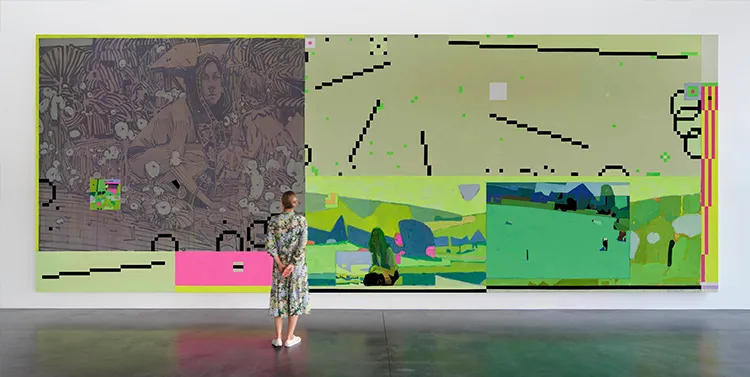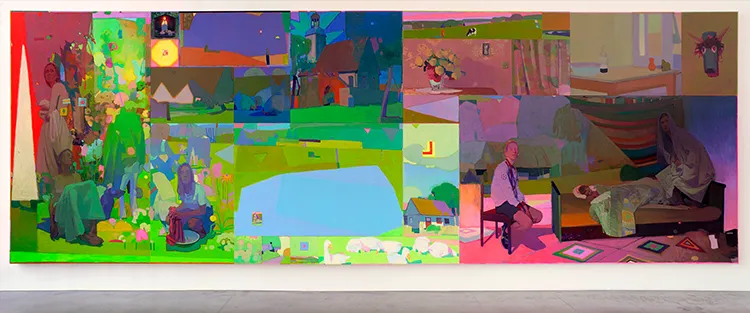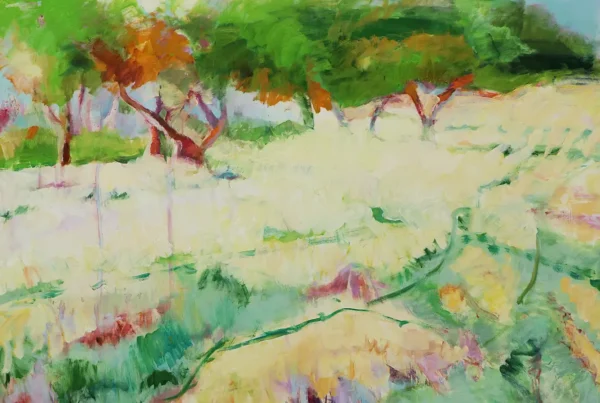Przemek Blejzyk: A Journey from Murals to Studio Art
Przemek Blejzyk, often recognized under his artistic moniker “Sainer,” has made an indelible mark on the global art scene, particularly through his large-scale murals. These vibrant works, painted on urban landscapes, catapulted him to international recognition. However, in recent years, Blejzyk has shifted his focus from muralism to more intimate studio painting. This transition, while gradual, has allowed him to explore the depths of his artistic process in a controlled environment, away from the limitations of public spaces. This shift marks a significant evolution in his creative journey, as it reflects his desire to refine and experiment with his craft in new ways.
For years, Blejzyk thrived on the dynamism and immediacy of mural painting, where the scale and public nature of the work demanded a different kind of energy. However, as he grew artistically, the constraints of working on large outdoor canvases became apparent. In his studio, Blejzyk found the freedom to dive deeper into his ideas, developing compositions with more nuance and precision. The studio space provides him with a setting to push boundaries and experiment with techniques that are difficult to achieve in outdoor settings. This move represents not just a change in medium but a transformation in how Blejzyk approaches art, giving him more space to challenge himself creatively.
This transition also signifies a broader exploration of balance for Blejzyk. Studio painting offers a contrast to his mural work, where he can now explore new artistic challenges. By stepping away from the physical demands of murals, Blejzyk has embraced a more introspective process, allowing his ideas to simmer and develop more fully. The result is an evolving body of work that continues to push the boundaries of his earlier achievements, highlighting his growth as an artist dedicated to constant reinvention.

Przemek Blejzyk: Melding Tradition with Modernity
Blejzyk’s work uniquely blends the influence of Impressionism with contemporary digital aesthetics, resulting in a style that is both timeless and distinctly modern. At first glance, these two seemingly disparate worlds may appear incompatible. However, for Blejzyk, they converge on a shared focus: perception. Impressionism, known for capturing fleeting moments of light and atmosphere, resonates with Blejzyk’s desire to represent the ephemeral nature of human experience. In contrast, digital aesthetics, shaped by the fast-paced, fragmented way we consume images today, reflect a more modern reality where perceptions are constantly shifting and layered.
In his paintings, Blejzyk skillfully merges these two influences, creating works that are both reflective and forward-looking. He often speaks about the parallels between Impressionist techniques, which emphasize mood and light, and the fragmented, window-like nature of digital imagery. His compositions feel multi-dimensional, as if they are capturing multiple moments or perspectives simultaneously. This blend of techniques allows Blejzyk to engage with the complexities of modern life, where technology has profoundly altered how we see and experience the world.
The result is a unique visual language that resonates on both an emotional and intellectual level. His art navigates the tension between nature and technology, tradition and innovation, creating works that are deeply layered and textured. In this way, Blejzyk’s paintings serve as a reflection of contemporary life, where digital screens and natural landscapes often exist side by side, shaping our understanding of reality. This fusion of old and new invites viewers to reconsider their own perceptions and the evolving nature of how we experience the world.

Landscapes as Abstraction: A New Direction
Landscapes have always played a pivotal role in Przemek Blejzyk’s work, but his approach to them is anything but conventional. Instead of focusing on traditional, detailed depictions of nature, he has reimagined landscapes as simplified compositions that emphasize mood, color, and form. For Blejzyk, landscapes serve as a conduit to explore the relationship between shapes and colors, rather than as literal portrayals of nature. This abstraction has become increasingly central to his practice, allowing him to capture the essence of a place while stripping away unnecessary detail.
One of Blejzyk’s key techniques in landscape painting is merging multiple perspectives into a single composition. He likens this to looking through several windows at once, a concept influenced by the fragmented nature of digital screens. This method allows him to play with scale and perspective in new ways, creating compositions that feel both expansive and intimate. By reducing landscapes to their simplest elements, Blejzyk is able to focus on the interplay between shapes and colors, using just a few hues to evoke the atmosphere of a place. His landscapes are not about precise realism but about capturing the emotional resonance of a scene.
This focus on abstraction also ties into his broader artistic exploration of form and color. In his recent exhibitions, including “KOLOOR” and “Kolorytm,” Blejzyk has pushed the boundaries of landscape painting even further, experimenting with how abstract compositions can evoke a sense of place. By distilling landscapes down to their essential components, he creates works that are both visually striking and conceptually rich. For Blejzyk, landscapes are not just a subject to be painted but a means to explore the fundamental building blocks of his art—shape, color, and composition.

Przemek Blejzyk: Color as Composition
For Przemek Blejzyk, color is not just a component of his paintings; it is the foundation upon which his entire creative process is built. His vibrant and often unexpected color choices are central to the emotional impact of his work, creating compositions that are as much about color as they are about form or subject matter. Blejzyk views color as a way to express movement, rhythm, and energy, likening his approach to music, where each hue acts as a note that contributes to the overall harmony—or tension—within the piece.
The role of color in Blejzyk’s work is particularly evident in the way he constructs his compositions. He is constantly experimenting with how different colors interact, often finding unexpected harmonies or deliberately creating contrasts that evoke a particular mood or atmosphere. His use of color is intuitive yet highly considered, allowing him to create dynamic compositions that guide the viewer’s eye across the canvas. Whether it’s a landscape or a more abstract piece, Blejzyk’s color choices are always at the forefront, shaping the entire experience of the painting.






